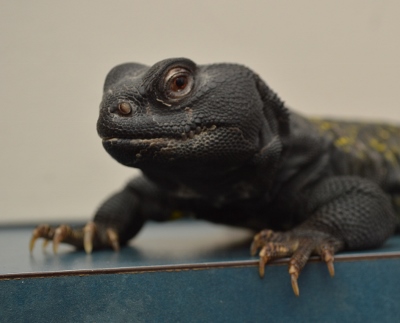
The uromastyx is returning to her burrow after spending November in the spotlight as our latest Animal of the Month on Twitter. All month long we tweeted about these gentle sun-loving reptiles and we hope you were following us @ExoticPetVets and enjoying our fun and fascinating facts. If you missed any, we have a summary for you. Did you know?:
- Uromastyx (Uromastyx spp.) is a genus (taxonomic group) of lizards that includes at least 15 different species.
- Uromastyx are also commonly known as spiny-tailed lizards, mastigures or dabb lizards.
- The name “uromastyx” is from the Ancient Greek (ourá = tail mastix = whip)
- The nickname of spiny-tailed lizard comes from the uromastyx tail which has rows of spikes.
- Swinging their muscular spiky tails, hissing & showing their teeth are defense mechanisms uromastyx use against predators.
- Uromastyx sleep in burrows with their spiky tails facing outwards to create a buffer between themselves and predators.
- Uromastyx are found across most of northern Africa and the Middle East.
- In the wild, uromastyx live in hot and rocky desert environments.
- Uromastyx are diurnal reptiles, meaning they are active during the day and they sleep at night.
- At night, uromastyx will sleep under rocks or in rocky crevices in burrows which they dig themselves.
- Because uromastyx live in the desert in the wild, they need a hot area to bask in while in captivity.
- In captivity uromastyx should have a daytime basking area warmed by a heat bulb to 110 – 120 degrees F (43 – 48 Celsius).
- The heat bulb can be a broad-spectrum UVA/UVB so uromastyx can process calcium which is critical to their bone health.
- Combination UVA/UVB bulbs are the most convenient for uromastyx in captivity.
- Uromastyx in captivity can also have separate UVA and UVB fluorescent or compact fluorescent bulbs.
- There should also be a non-basking area for uromastyx in captivity that is about 88 – 104 degrees F (31 – 40 Celsius).
- Nocturnal temperatures can go down to about 70 degrees F (21 Celsius) for a uromastyx in captivity.
- Most adult uromastyx species grow be between 10 and 18 inches (25 – 45 cms) in length.
- The largest uromastyx species is the Egyptian uromastyx, which can exceed 30 inches (76 cms).
- Uromastyx eat a mostly vegetarian diet, although they may eat insects occasionally.
- Juvenile uromastyx can eat insects more often as they need more protein in their diet.
- Uromastyx get their water intake through the moisture of the vegetation they eat.
- In captivity, uromastyx may not drink out of a water bowl, but a small one should be available to them.
- Uromastyx are friendly and gentle lizards. Only rarely do they bite people.
- If uromastyx feel threatened by a person, they are more likely to swing their tails to defend themselves than bite.

